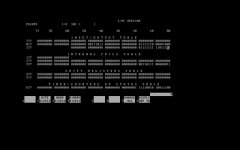ericnovvak
Member
Hello all,
Another question from the newbie..
I am currently building a shutdown key for an oil and gas application based off of logic from a DOS6 Fanuc logicmaster program. Its proving to be a frustrating task as none of the contacts nor the coils have any descriptions. They are merely identified by numbers.
I have been toying around with the program (which is completely barbaric and antiquated to me) to try and differentiate which points are physical INPUTS and physical OUTPUTS compared to internal bits, or internal memory points, etc...
Is there a way to extrapolate this information from fanuc? I have scanned through the program to the best of my (limited) ability and see nothing.. Im afraid that I will have to dig up 25+ year old drawings and go page by page to figure this stuff out, so be fore I do that maybe one of you can help me out.
Ive attached a screen shot of the Display Reference Table and my assumption is that the 0 (zeros) denote an OUTPUT and the 1 (ones) are for INPUTS. When I hover over any specific point it tells me which I/O # it belongs to so if my assumption is correct I may be able to save SOME time, but if you know of better or easier ways (or completely different ways for that matter) I am all ears/eyes.
also, any tips/advice about shutdown keys in general would be greatly appreciated as well.
Thanks all in advance.

Another question from the newbie..
I am currently building a shutdown key for an oil and gas application based off of logic from a DOS6 Fanuc logicmaster program. Its proving to be a frustrating task as none of the contacts nor the coils have any descriptions. They are merely identified by numbers.
I have been toying around with the program (which is completely barbaric and antiquated to me) to try and differentiate which points are physical INPUTS and physical OUTPUTS compared to internal bits, or internal memory points, etc...
Is there a way to extrapolate this information from fanuc? I have scanned through the program to the best of my (limited) ability and see nothing.. Im afraid that I will have to dig up 25+ year old drawings and go page by page to figure this stuff out, so be fore I do that maybe one of you can help me out.
Ive attached a screen shot of the Display Reference Table and my assumption is that the 0 (zeros) denote an OUTPUT and the 1 (ones) are for INPUTS. When I hover over any specific point it tells me which I/O # it belongs to so if my assumption is correct I may be able to save SOME time, but if you know of better or easier ways (or completely different ways for that matter) I am all ears/eyes.
also, any tips/advice about shutdown keys in general would be greatly appreciated as well.
Thanks all in advance.




